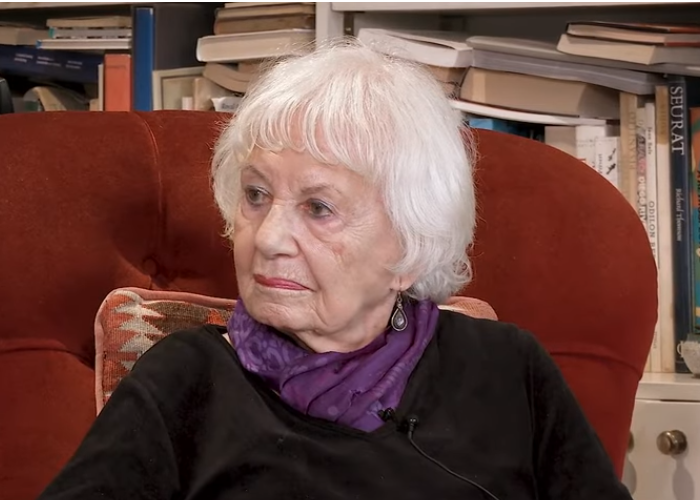The loss of Ruth Posner’s only son, Jeremy, was the one major tragedy that marred her life, which was otherwise a symphony of tenacity, creativity, and intelligence. Her later years were shaped with extraordinary depth and sensitivity by the silence left in her heart by his death at the age of thirty-seven, which she carried with calm grace. Despite having tragic roots, her narrative served as a testament to the coexistence of love, memory, and purpose—even in the face of unfathomable agony.

Ruth Wajsberg was born in Poland and grew up in the shadow of Nazi rule. Her early years were characterized by fear and survival; she and her father managed to flee the Radom Ghetto by posing as a Catholic. She had a deep appreciation for the frailty of life as a result of that chapter, which was both horrifying and courageous. The way she dealt with all of her losses, even the indescribable one of losing her baby, was shaped by her early experience.
Ruth Posner – Personal and Professional Information
| Full Name | Ruth Posner (née Wajsberg) |
|---|---|
| Birthplace | Poland |
| Nationality | Polish-born British |
| Occupation | Actress, Dancer, Choreographer |
| Known For | Holocaust survivor, London Contemporary Dance Company, Royal Shakespeare Company |
| Award | British Empire Medal (BEM) – 2022 for Holocaust Education |
| Husband | Michael Posner (Chemist, UNICEF official) |
| Son | Jeremy Posner (Deceased at age 37) |
| Died | 23 September 2025 (Assisted suicide, Switzerland) |
With little more than her bravery and a will to start over, Ruth fled to Britain at the age of sixteen following the war. She quickly became involved in the arts, dancing and choreographing with the London Contemporary Dance Company, where she found a creative outlet for her restless energy. She saw dancing as a means of expressing what words could not, and her career was founded on passion rather than fame. She met her husband, Michael Posner, there. He is a clever chemist who traveled continents to support humanitarian issues with UNICEF.
Their relationship was based on modest adoration and a common belief. Although their rhythms were different, their spirits were the same: she was expressive and intuitive, while he was methodical and analytical. Together, they made a house full of books, art, laughter, and a steadfast faith in goodwill. Jeremy, their only son, was the embodiment of their union; he was a combination of his mother’s empathy and his father’s intelligence. Friends recall him as a man who was adored by both parents who was intelligent, inquisitive, and kind. Although his premature passing was tragic, Ruth hardly ever discussed it in depth. “Some losses become part of your breathing — you live with them quietly,” she once said.
Her signature was that calm strength. Ruth remained involved in her community despite the burden of her personal sorrow. Before switching to acting and eventually joining the Royal Shakespeare Company, she worked for seventeen years with the London Contemporary Dance Company. Her performances were elegant and profound. Her art, especially in her final years, frequently seemed to reflect her tenacity; it was exact, measured, and incredibly personal.
Following her retirement from performing, she discovered a new calling in Holocaust teaching and began giving lectures at UK colleges and universities. Her speeches were genuine discussions rather than prepared monologues, and she did so with humor, humility, and a very clear sense of purpose. She felt that the goal of recollection was to stop pain from happening again rather than to relive it. She once remarked, “I tell my story to show that survival can be a light, not to dwell on darkness.” In 2022, she received the British Empire Medal in recognition of her efforts, which she accepted “for those who didn’t make it out.”
Even in her older years, friends and coworkers referred to her as “radiant.” She was referred to as “the most vibrant, amazing woman” by her close friend, playwright Sonja Linden, who praised her for approaching age with comedy and honesty. However, such vitality was accompanied by an implicit understanding of loss. Even though Ruth and Michael had spent a long and happy life together, the quiet core of their relationship remained their biggest sorrow: Jeremy’s death. “We had an interesting and varied life, and except for the sorrow of losing Jeremy, we enjoyed our time together,” they said in their final note to friends, which they sent just before their assisted death in Switzerland.
Their straightforward but profoundly poignant message encapsulated the remarkable balance they had learned to maintain between happiness and sorrow, between the abundance of life and its unavoidable absence. The couple, who were ninety-six and ninety-seven years old, decided to pass away together at a facility close to Basel, stating that their deteriorating health and lack of energy had made life seem like just existing. Their choice was peaceful, unrepentant, and mutual; it was an act of independence that mirrored their enduring dedication to dignity and reason.
For her time, Ruth’s perspective on assisted suicide was especially novel and sympathetic. She felt that maintaining control over life’s last chapter was more important than choosing death. Linden told reporters that “if the law here had permitted it, she wouldn’t have had to make those arrangements abroad.” In this way, Ruth’s last deed turned into a silent act of advocacy—a private act that provoked public thought.
After her passing, there were incredibly moving tributes. She was hailed as “an extraordinary woman who made it her mission to reach as many young people as possible” by the Holocaust Educational Trust. Ruth’s warmth and charm “left an impression on everyone she met,” according to Karen Pollock, its CEO. For “educating future generations and never shying away from the fight against hatred,” she received praise from the Campaign Against Antisemitism.
Jeremy’s memory persisted throughout all of this as her unseen companion, the quiet voice in her activism, art, and stories. She channeled her love for him into empathy for others, according to many who knew her well, and carried him with extraordinary calm. Her fortitude was especially noteworthy as it never turned into resentment. Even when discussing death, she did so gently since she believed it to be a necessary part of a cycle that was terrible but still had purpose.
Ruth frequently stated that she feared indifference—the inability to recall, feel, or learn—rather than death. Her life served as an example of how memory may promote understanding and heal. Instead of closing her heart, losing Jeremy made it bigger. She transformed her own experience into collective wisdom, her anguish into purpose, and her sadness into service.
